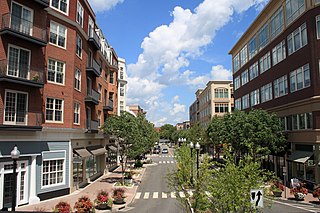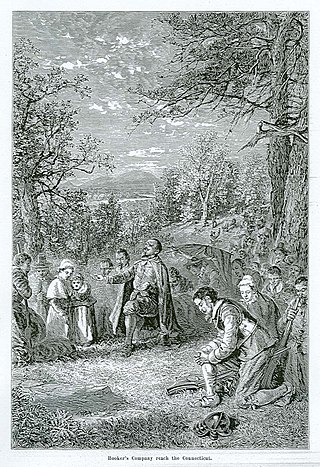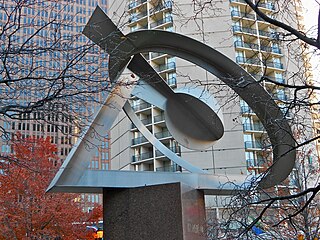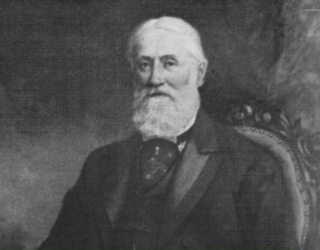
Hartford is the capital city of the U.S. state of Connecticut. The city, located in Hartford County, had a population of 121,054 as of the 2020 census. Hartford is the most populous city in the Capitol Planning Region and the core city of the Greater Hartford metropolitan area.

New Britain is a city in Hartford County, Connecticut, United States. It is located approximately 9 miles (14 km) southwest of Hartford. The city is part of the Capitol Planning Region. According to 2020 Census, the population of the city is 74,135.

West Hartford is a town in Hartford County, Connecticut, United States, 5 miles (8.0 km) west of downtown Hartford. The town is part of the Capitol Planning Region. The population was 64,083 at the 2020 census.

Thomas Hooker was a prominent English colonial leader and Congregational minister, who founded the Connecticut Colony after dissenting with Puritan leaders in Massachusetts. He was known as an outstanding speaker and an advocate of universal Christian suffrage.

James William Charles Pennington was an American historian, abolitionist, orator, minister, writer, and social organizer. Pennington is the first known Black student to attend Yale University. He was ordained as a minister in the Congregational Church, later also serving in Presbyterian churches for congregations in Hartford, Connecticut, and New York. After the Civil War, he served congregations in Natchez, Mississippi, Portland, Maine, and Jacksonville, Florida.

William Huntington Russell was an American businessman, educator, and politician. Notably, he was a co-founder of the Yale University secret society Skull and Bones, along with Alphonso Taft.
Frederick Trent Stanley was an American industrialist born in New Britain, Connecticut.

Robert William Vonnoh was an American Impressionist painter known for his portraits and landscapes. He traveled extensively between the American East Coast and France, more specifically the artists colony at Grez-sur-Loing.

Guy Carleton Wiggins NA was an American impressionist painter. He was the president of the Connecticut Academy of Fine Arts, and a member of the Old Lyme Art Colony. He did many paintings of New York City's snowy streets, landmarks and towering skyscrapers during winter.

The New Britain Museum of American Art is an art museum in New Britain, Connecticut. Founded in 1903, it is the first museum in the country dedicated to American art.
Deane Galloway Keller was an American artist, academic and author. Keller was a draftsman, painter, sculptor, and teacher who instructed students in the visual arts for forty years, most notably in figure drawing and the artistic application of human anatomy. He is credited with explaining that "drawing offers a unique record of an encounter with a culture, of experience transformed from fleeting moment to lasting resonance."

The Florence Griswold Museum is an art museum at 96 Lyme Street in Old Lyme, Connecticut centered on the home of Florence Griswold (1850–1937), which was the center of the Old Lyme Art Colony, a main nexus of American Impressionism. The museum is noted for its collection of American Impressionist paintings. The house was designated a National Historic Landmark in 1993. The site encompasses 12-acres of historic buildings, grounds, gardens, and walking trails.
William Wadsworth was an early pioneer of New England, a founder of Hartford, Connecticut and the patriarch of numerous and prominent Wadsworth descendants of North America, including the poet Ezra Pound.

Dudley Vaill Talcott was an American sculptor, author and illustrator.

Ebenezer Kingsbury Hunt was a prominent physician in Hartford, Connecticut.
Philip Corbin (1824-1910) was an American industrialist who founded P&F Corbin Company, a major manufacturer of decorative hardware. It was first based in New Britain, Connecticut, where he founded it with his brother Frank Corbin.

Allen Butler Talcott was an American landscape painter. After studying art in Paris for three years at Académie Julian, he returned to the United States, becoming one of the first members of the Old Lyme Art Colony in Connecticut. His paintings, usually landscapes depicting the local scenery and often executed en plein air, were generally Barbizon and Tonalist, sometimes incorporating elements of Impressionism. He was especially known and respected for his paintings of trees. After eight summers at Old Lyme, he died there at the age of 41.

Lyme Art Association (LAA) is a nonprofit art organization established in 1914, with roots going back to 1902. The LAA maintains a historic art gallery located at 90 Lyme Street in the Old Lyme Historic District, Old Lyme, Connecticut. The gallery was built in 1921 to a design prepared by the architect and artist Charles A. Platt. The association holds exhibitions throughout the year, featuring the work of member artists as well as visiting ones, with an emphasis on representational art The building has a north-light studio, where the association conducts classes year-round.
John deKoven Alsop was an American politician, insurance executive, and soldier. A Republican, Alsop served in the Connecticut House of Representatives and unsuccessfully ran for governor of Connecticut in 1958 and 1962. He was known as "one of Connecticut's most influential and colorful Republicans."

James Talcott (1835–1916) was an American factor, based in New York City. He established James Talcott, Inc., one of the oldest and largest 19th-century factoring houses in the United States.















